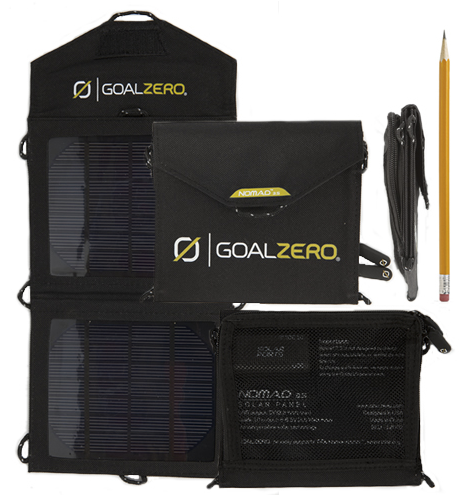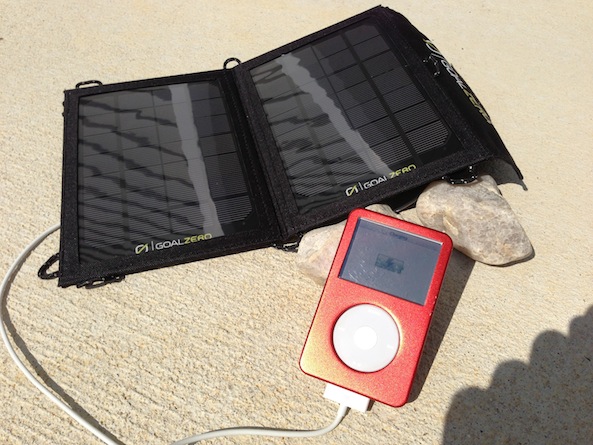
A city-slicker that fancies himself an outdoorsman, I had been on a quest to find an iOS device solar charger for a couple months. After stumbling into an REI, the GOAL ZERO product line piqued my interest. When hiking, camping, hunting, traveling, or when the world ends, finding a power source may be difficult. If we are all Denzel Washingtons, rocking out to our iPods while we hunt for the Book of Eli, then a consistent source of USB power is as important as our favorite post-apocalyptic weapon…
Design
The Nomad 7 solar panel charger and Guide 10 Plus battery pack reserve charger come packaged together in the Guide 10 Plus Adventure Kit. Solar panel charging is obviously a great alternative to going without power on your next excursion. Unfolded, the Nomad 7 solar panel kit is 17″ x 9″ x 0.1″ and 6″ x 9″ x 1″ folded, which is a decent package for .8 pounds. On the back of the solar panels, in an integrated pocket there is an output adapter with three options: USB 5V; 12V; solar port 6V. The USB port is designed for small/medium USB devices such as iPods and iPhones. Car charger adapters will work with the 12V output for items like GPS power units. The solar 6V port is designated to charge the Guide 10 Plus battery pack.

Guide 10 charging dock is perfect for storing solar power in battery form and comes with 4 – AA nickel metal hydride (NiMH) batteries. This battery dock will charge from the Nomad 7 solar panels or a laptop. Once charged, plug any USB powered device, including iPads, into the output port to charge. Weighing in at .4 pounds and a compact 2.5″ x 4″ x 0.75″, the total package with the Nomad 7 weighs 1.2 pounds. Guide 10 will pack into the built in pocket on the solar panels, then the Nomad 7 folds up into a compact bundle to throw-and-go in your favorite day pack.
However, if your panels are in your pack, then nothing is charging. Thankfully, GOAL ZERO is one step ahead and added hook loops on all sides of the Nomad 7. To get a charge on the go, unfold the panels and clip the housing onto the back of your pack with zip ties or carabiners and plug in your iOS device or Guide 10. Once the sun goes down, pull out the Guide 10, which has a built in flashlight to find your way around the camp site before charging you iPod over night, in the dark. For a full product tour, check out the GOAL ZERO guided Adventure Kit page and the user guide.
My experience
As a test subject, I chose my 5th generation iPod Classic. The goal of my test was to determine if an iDevice could be charged in one afternoon in a reasonable amount of time, from dead to charged. When placing my iPod in direct sunlight from 1:15PM – 6:15PM it received a 75% charge level when starting from dead. Restarting the extremely unscientific experiment, I tried with my iPhone 4. This time, it topped out around 100% in slightly over 5 afternoon hours.
According to the GOAL ZERO website, the unit should charge a cell phone or MP3 player in 1-3 hours or smart phone in 2-4 hours. While my limited experiments do not hit those exact benchmarks, it is important to remember all of the variations in solar technology. What was the angle of the panel in relation to the sun? Was there assorted cloud cover? Etc. While I tried my charge on clear days, there are still factors that will vary results on a day-to-day basis.

Conclusion
Overall, I am a big fan of the GOAL ZERO Guide 10 Plus Adventure Kit, which will set you back a cool $159.00 (only $119 on Amazon). I am not denying the fact that it takes a significant amount of time to charge your iPhone or iPod from the unit, but the whole package has a wide offering. The panels are large and weather resistant. The nylon housing with multiple power outputs and even a built in carrying pouch make the Nomad 7 a well-balanced device for the price. If you are constantly on-the-go or an outdoorsman, it is a great addition to your camping gear or bug-out pack for you World War Z worry-warts. The ability to turn sunlight into usable power for multiple devices has extremely high advantages and GOAL ZERO delivers. If you are looking for a cheaper option, check out the Guide 10 Plus Mobile Kit which is a little less powerful and doesn’t offer 12V adapter, but comes in at $129.00. Finally, thanks to my friends over at GOAL ZERO for providing the review unit.
Pros:
- Includes battery pack, solar panels, charging adapters and 4 rechargeable batteries
- Turns sunlight into power, which seems obvious, but is quite exciting
- Small and compact, comes built into its own travel pouch
- Charge two USB devices at once, one from solar panel, one from battery backup pack
- Use your device while charging
Cons:
- Expensive
- Doesn’t charge extremely fast and will vary with weather conditions
Anyone currently preparing for the ensuing apocalypse with technology gadgets? Would you fork out $120 for a solar powered charging kit?